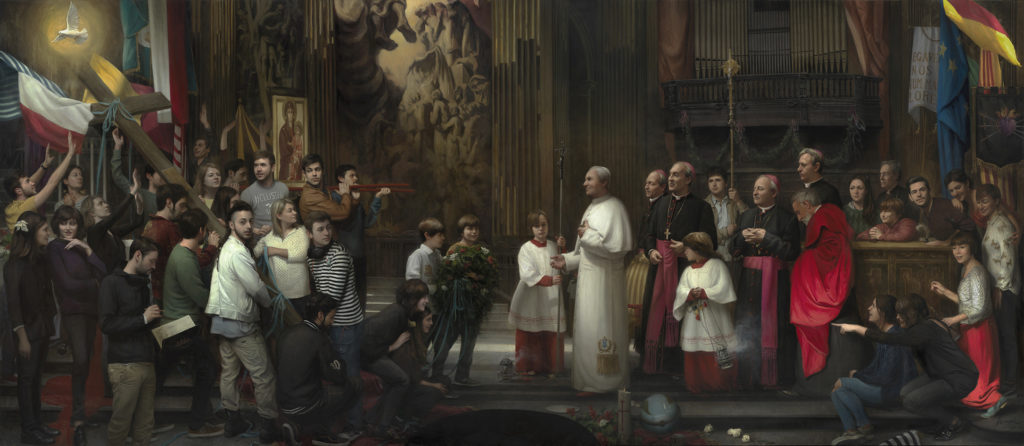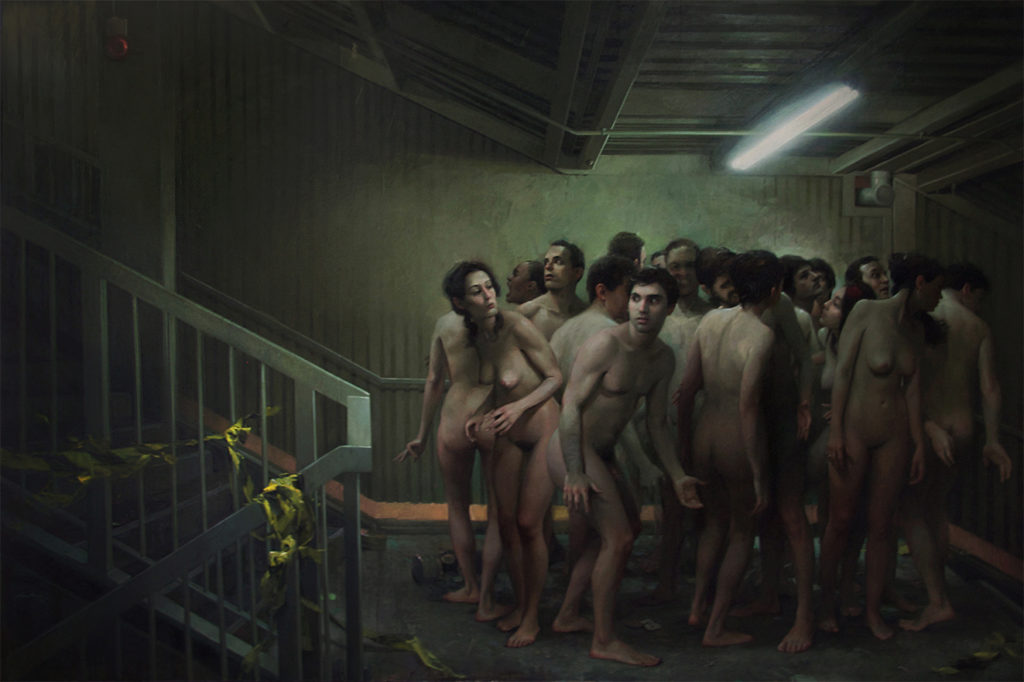THE CARMINE HOTEL
[2023]
In CARMINE HOTEL, each guest draws us into their intimate world, tantalizing our senses yet keeping their secrets close. Through themes of strength, fragility, and beauty, Alamà explores the realm of eroticism and allure. They appear flirtatious yet distant, devoted yet reserved, exposed but elusive. The series embodies a captivating display of elegant gestures of surrender, where gazes whisper softly, «almost».
INFERNO. THE DIVINE COMEDY
[2020-2021]
«Lasciate ogni speranza» abandon all hope, reads the inscription on the entrance of Dante’s Inferno. The sinister engraving warned all the damned that once they entered the abyss they would not be able to get out. Jordi Díaz Alamà invites you to cross the threshold of this unique series where tradition and the art of the present, universal literature, and the contemporary visual arts converge. This is his most ambitious project to date, a journey through Hell in light and shadow, a vast network of landscapes, characters, and abstractions. This exhibition also includes some of the works by virtuoso Polish sculptor Grzegorz Gwiazda, a series of splendid pieces representing the figure of the Florentine genius.
RED STUDIO
[2018-2019]
Alamà offers through this series of saturated, vivid and imposing reds, a privileged peek inside the universe of the painter’s studio, the practice of working with life models and the vast plurality in sensuality. Red Studio synthesizes the many layers of technical research the artist has acquired over the last decade. Academicism and abstraction coexist again on the canvas: a new aesthetic chapter carried out by an overwhelming expressive force in the form of a dance between the measured and the vigorous brushstroke.
#CLÁSICOSDESOLLADOS
Serie Negra (Black Series)
[2018]
Following the pictorial discourse of #ClásicosDesollados, the Black Series presents a new twist in the personal reinterpretation of the classics. Alamà obscures the compositions and the narrative tone of his works by means of night skins and visual distortions. The Black Series perseveres in the game of intertwining paint coatings and historical layers.
#CLÁSICOSDESOLLADOS
[2017-2018]
This intricate compilation of studies or ‘amusements’, as described by the artist, draws upon a curated selection of classical works as its foundational backdrop. The collection encompasses pieces by eminent artists such as Velázquez, Goya, Géricault, Friedrich, Manet, and Degas. Alamà uses acrylic and resin to breathe new life beneath the surface, tearing canvases and repositioning folds, much like a surgeon’s skillful touch. This metaphorical peeling exposes the classics’ core, revealing their timeless essence.
In an image-centred society, where fleeting glances preclude serene contemplation of reality, there exists a fragile equilibrium. Within this balance – achieved through distortion and smudging, as both the architect and eraser of art, while locked onto a charged and perilous trajectory – Alamà unveils contemporary challenges using canonical figures and scenes. Their enduring significance as testaments to humanity transcends time, grounded in an eternal grasp of our essence.
LA CRUZ DEL JUBILEO
[2015-2016]
Commissioned by the Congregació dels Dolors, Alamà painted the «The Jubilee Cross» between 2015 and 2016 for Vic’s Església dels Dolors. The artwork portrays a fictional episode from the World Youth Days, depicting the presentation of the Jubilee Cross to Pope John Paul II.

REINAS DE LA NOCHE
[2014-2015]
This collection is like a long night during which corners of an opaque city are gradually illuminated by Alamà’s brush. In these corners, amidst lavish furnishings and fading noble fabrics, unsettling characters emerge – figures that present themselves and thrust forward with a glance or gesture, yet guard their nature for themselves, masked by the night and an aura of fiction and play, by a nocturnal veil that employs sensuality, allure, and strength to provide shelter for fragility and intimacy. Here, Alamà works with touches of exoticism and suggested textures, with a fervent warmth that transcribes a cold and disturbing reality. In this series, we witness Alices who neither fall into slumber nor return to the realm of things, burrows where truth and what is exhibited contend, projections of a world between two worlds, stages of a subconscious teeming with perversions that seek a way to break through.
ARTISTAS QUE SE VENDEN
[2012-2013]
This collection is based on the premise that we all have a price. Sensuality strives to take the lead, functioning tonally and thematically like a «basso ostinato,» but it’s the exposure of fracture and fragility that prevails – the high-pitched and cutting note that makes us understand that these women have succumbed to a kind of perversion that is truly foreign to them. Amid the struggle to maintain a facade of strength against the overt display of excessive sexuality, Alamà brings forth suspicions of pretense in the faces of these women: plastic smiles, fragile serenities, reckless audacity.
One of them searches within the remains of tea at the bottom of a cup, seeking reasons for why she has accepted to go so far. Another opens her arms defiantly while seated on the sofa, even as her legs take refuge, evading the aggression she imposes upon herself and feigns.
GENERACIÓN DEL 86
[2011]
This is a collective portrait of Alamà’s generation of companions. They appear absent-minded, in the middle of a landing between stairs, as if they do not know which way to go, whether to go up, down, or stand still. The work is an allegory of the sense of frustration of an entire generation who, just after finishing their studies, saw how the economy of the West collapsed, how the opportunities for decent work vanished, and how the pretense of the bonanza of the end of the century vanished in the face of the challenges of the new millennium. It portrays a generation that stood naked on the landing of history, that withdrew into itself, disoriented, under the sad shelter of a cold, artificial, fluorescent light. However, one of the characters looks towards the upper flight of stairs. He knows that even barefoot or blind, he has to go on climbing, go on living, and find his way.
Winner of the Figurativa’s 11 competition organised by the Fundación de las Artes y los Artistas in conjunction with the MEAM in Barcelona.

EARLY WORKS